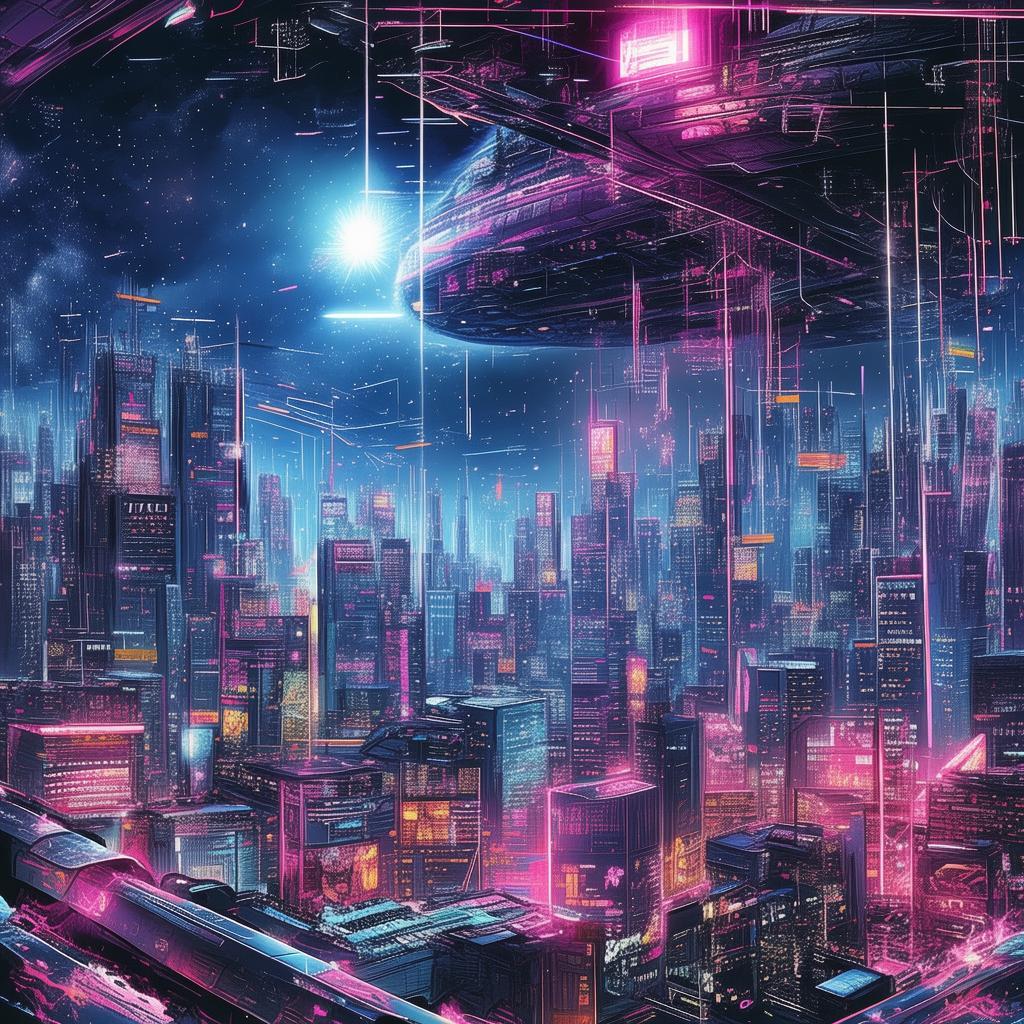Atomic Echoes: The Resonance of Tomorrow
In the year 2045, the Atomic Age aesthetic had become more than a style—it was a way of life. The war had left a scars on the world, but it had also forged a new vision for humanity, a vision that celebrated the raw power and beauty of atomic energy. The architecture was a blend of sleek, futuristic designs and the rustic charm of the atomic era, with neon lights and bold geometric shapes adorning the streets and buildings.
Amidst this backdrop, a young artist named Lila navigated the bustling cityscape of Neo-Tokyo, her hands always at work, painting the city's pulse onto her canvases. She was a part of the Resonance Collective, a group of artists who sought to capture the essence of the Atomic Age in their work, blending it with the modern, digital age to create a unique aesthetic.
One evening, while wandering through the neon-lit streets, Lila stumbled upon an old, dusty bookstore tucked away in an alleyway. The scent of aged paper and the faint glow of streetlight made the place seem like a time capsule from a bygone era. Curiosity piqued, she pushed open the creaky door and stepped inside.
The interior was a labyrinth of shelves, each crammed with books of all shapes and sizes. She wandered aimlessly, her fingers brushing against the spines of old tomes, until she noticed a peculiar volume with a silver emblem on its cover—a radiation symbol, intertwined with a stylized atom. The title, "The Resonance of Tomorrow," intrigued her, and she pulled it from the shelf.
The book was a relic from the Atomic Age, filled with illustrations that seemed to pulse with life. As Lila flipped through the pages, she found a hidden compartment within the spine. Inside was a small, metallic device, shaped like a stylized atom. She took it out and noticed that it had a holographic screen, which flickered to life as she touched it.
The device displayed a series of cryptic messages and coordinates, scattered across a map of Neo-Tokyo. Lila's heart raced as she realized that these messages were a guide to locations where she could find pieces of a larger puzzle. She knew that the Resonance Collective had been searching for these pieces for years, hoping to uncover the truth behind the enigmatic art movement that had inspired their work.
With the device in hand, Lila set out on a quest to uncover the secrets of the Atomic Age aesthetic. Her journey took her to abandoned factories, forgotten subway stations, and hidden underground bunkers. Each location held a piece of the puzzle, and with each discovery, the truth behind the Resonance of Tomorrow became clearer.
As Lila delved deeper into the mystery, she encountered other artists who had been searching for the same answers. They formed an unlikely alliance, sharing their discoveries and theories. Among them was Kaito, a brilliant scientist who had been researching the effects of atomic radiation on the human psyche. He believed that the Atomic Age aesthetic was a manifestation of the collective subconscious, a reflection of the fear and hope that had emerged in the aftermath of the war.
The final piece of the puzzle led Lila and her newfound allies to an old, abandoned laboratory on the outskirts of the city. Inside, they found a collection of strange artifacts, each pulsating with a faint, rhythmic glow. It was here that they realized the true purpose of the Atomic Age aesthetic: it was a means of communication, a way to resonate with the past and influence the future.
The laboratory was a relic of a bygone era, but its technology was far ahead of its time. It was capable of sending messages through time, allowing the Atomic Age aesthetic to influence the present. Lila and her allies realized that the Atomic Age aesthetic was not just a style; it was a beacon of hope for a world that was still healing from the scars of war.
As they activated the laboratory's main console, a holographic projection of the Atomic Age aesthetic began to form, a blend of art and science that defied the boundaries of time and space. The Resonance of Tomorrow was not just a message from the past; it was a vision for the future.

The world watched in awe as the holographic projection grew, filling the sky with a kaleidoscope of colors and shapes. It was a reminder of the power of art, the power of collective memory, and the power of hope. The Atomic Age aesthetic had become more than just a style; it had become a symbol of resilience and unity.
Lila looked out at the crowd, her heart swelling with pride. She had uncovered the truth behind the Resonance of Tomorrow, and she knew that it was just the beginning. The Atomic Age aesthetic was a legacy that would resonate through time, inspiring future generations to create, to innovate, and to heal.
The city of Neo-Tokyo was a testament to the power of art and the enduring spirit of humanity. As the holographic projection continued to glow, Lila felt a deep sense of fulfillment, knowing that she had played a part in unlocking the Resonance of Tomorrow, the art movement that would echo through the ages.
✨ Original Statement ✨
All articles published on this website (including but not limited to text, images, videos, and other content) are original or authorized for reposting and are protected by relevant laws. Without the explicit written permission of this website, no individual or organization may copy, modify, repost, or use the content for commercial purposes.
If you need to quote or cooperate, please contact this site for authorization. We reserve the right to pursue legal responsibility for any unauthorized use.
Hereby declared.









